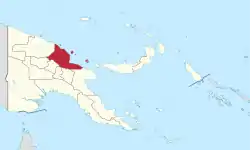Madang Province
Madang is a province of Papua New Guinea. The province is on the northern coast of mainland Papua New Guinea and has many of the country's highest peaks, active volcanoes and its biggest mix of languages. The capital is the town of Madang.
Madang Province
| |
|---|---|
 Flag | |
 Madang Province in Papua New Guinea | |
| Coordinates: 5°10′S 145°20′E | |
| Country | Papua New Guinea |
| Capital | Madang |
| Districts | |
| Government | |
| • Governor | Peter Yama 2017- |
| Area | |
| • Total | 28,886 km2 (11,153 sq mi) |
| Population (2011 census) | |
| • Total | 493,906 |
| • Density | 17/km2 (44/sq mi) |
| Time zone | UTC+10 (AEST) |
| HDI (2018) | 0.545[1] low · 13th of 22 |
Districts and LLGs and clans
Each province in Papua New Guinea has one or more districts, and each district has one or more Local Level Government (LLG) areas. For census purposes, the LLG areas are subdivided into wards and those into census units.[2][3][4]
Education
Tertiary educational institutions in Madang Province include:
- Madang Technical College
- Madang Marine Time College
- Madang Teachers College
- Divine Word University (DWU) is a national university and a leading tertiary institution in Papua New Guinea. Formerly Divine Word Institute, it was established by an Act of Parliament in 1980 and was established as a University in 1996. DWU It is ecumenical, coeducational and privately governed with government support.[5]
Provincial leaders
The province was governed by a decentralised provincial administration, headed by a Premier, from 1978 to 1995. Following reforms taking effect that year, the national government reassumed some powers, and the role of Premier was replaced by a position of Governor, to be held by the winner of the province-wide seat in the National Parliament of Papua New Guinea.[6][7]
Premiers (1978–1995)
| Premier | Term |
|---|---|
| Bato Bultin | 1978–1984 |
| Max Moeder | 1985–1986 |
| Andrew Ariako | 1986–1993 |
| provincial government suspended | 1993–1995 |
Governors (1995–present)
| Governor | Term |
|---|---|
| Peter Barter | 1995–1997 |
| Jim Kas | 1997–2000 |
| Pengau Nengo (acting) | 2000–2002 |
| Stahl Musa | 2002 |
| James Yali | 2002–2007 |
| Arnold Amet | 2007–2008 |
| Buka Malai (acting) | 2008–2009 |
| Arnold Amet | 2009–2011 |
| James Gau | 2011–2012 |
| Jim Kas | 2012–2017 |
| Peter Yama | 2017–2022 |
| Ramsey Pariwa | 2022–present |
Members of the National Parliament
The province and each district is represented by a Member of the National Parliament. There is one provincial electorate and each district is an open electorate.
| Electorate | Member |
|---|---|
| Madang Provincial | Ramsey Pariwa |
| Bogia Open | Robert Naguri |
| Madang Open | Bryan Jared Kramer |
| Middle Ramu Open | Jonny Alonk |
| Rai Coast Open | Kessy Sawang |
| Sumkar Open | Alexander Orme |
| Usino-Bundi Open | Jimmy Uguro |
Notable people
- Yolarnie Amepou - herpetologist and conservationist.
- Julia Mage’au Gray - choreographer and tattoo artist.
References
- "Sub-national HDI - Area Database - Global Data Lab". hdi.globaldatalab.org. Archived from the original on 2018-09-23. Retrieved 2020-04-18.
- National Statistical Office of Papua New Guinea
- "Final Figures". www.nso.gov.pg. 2011 National Population and Housing Census: Ward Population Profile. Port Moresby: National Statistical Office, Papua New Guinea. 2014. Archived from the original on 2015-09-06. Retrieved 2019-06-04.
- "Census Figures by Wards - Momase Region". www.nso.gov.pg. 2011 National Population and Housing Census: Ward Population Profile. Port Moresby: National Statistical Office, Papua New Guinea. 2014. Archived from the original on 2019-05-19. Retrieved 2019-06-04.
- Divine Word University
- May, R. J. "8. Decentralisation: Two Steps Forward, One Step Back". State and society in Papua New Guinea: the first twenty-five years. Australian National University. Archived from the original on 1 April 2019. Retrieved 31 March 2017.
- "Provinces". rulers.org. Archived from the original on 28 July 2018. Retrieved 31 March 2017.
External links
- Edwin Cook and Susan Pflanz Cook Collection from the Edwin Cook Papers. MSS 187. Special Collections & Archives, UC San Diego